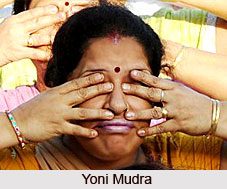 Yoni mudra helps to make one self completely detached from the chaos of the outer world. Yoni-mudra gets its name yoni, meaning "uterus", because like the baby in the uterus, the practitioner has no external contact with the world and, therefore, no externalisation of consciousness. In Yoni Mudra yogis not only visualise each one of the chakras, but also listen intently to inner sounds or what is popularly called "the mystic sounds". The yoga texts say that if you are right-handed, you will hear these sounds in your right ear and if you are left-handed, you will hear these sounds in your left ear. The physical posture that is recommended is siddhasana because it is considered the best for sealing off the lower apertures. However, if siddhasana is not possible, one should try the padmasana. The yogi then seals all the upper apertures.
Yoni mudra helps to make one self completely detached from the chaos of the outer world. Yoni-mudra gets its name yoni, meaning "uterus", because like the baby in the uterus, the practitioner has no external contact with the world and, therefore, no externalisation of consciousness. In Yoni Mudra yogis not only visualise each one of the chakras, but also listen intently to inner sounds or what is popularly called "the mystic sounds". The yoga texts say that if you are right-handed, you will hear these sounds in your right ear and if you are left-handed, you will hear these sounds in your left ear. The physical posture that is recommended is siddhasana because it is considered the best for sealing off the lower apertures. However, if siddhasana is not possible, one should try the padmasana. The yogi then seals all the upper apertures.
The process of Yoni mudra
* First, putting the thumbs in the ears to close the ear holes one should keep his back straight.
* Next he has to close the eyelids and place the tips of the index fingers on them. If the eyeballs feel disturbed by the pressure of the finger on the eyelids he should try drawing the eyelid down with the index fingers so that the only place where the fingers apply pressure is just below the eyes at the cheekbone.
* The middle fingers are to be pushed on the nostrils. The ring fingers are placed on the upper lip, while the little fingers rest under the lower lip.
* Each elbow should be pointed outwards: the right at a ninety- degree angle from the right side of the person, and the left elbow at a ninety-degree angle from the left side.
* There are two variations in the technique of breathing while doing the Yoni Mudra. The first is simply to stop pinching the nostrils with the middle fingers according to breathe in and out. In the other procedure, the nostrils are held tightly shut. The ring and little fingers stay put also, but the lips should be open in a gesture of whistling.
Benefits of Yoni mudra
The practice of yoni mudra is also called Sanmukhi mudra that means to close the seven gates or openings. This mudra helps in quietening the mind of the practitioner. Practicing this, one can find his nervous system to be calmed and stabled. He can redirect the attention to the inner world. This mudra helps to relax and maintain mental clarity. One can get rejuvenated mind after doing this mudra.




















